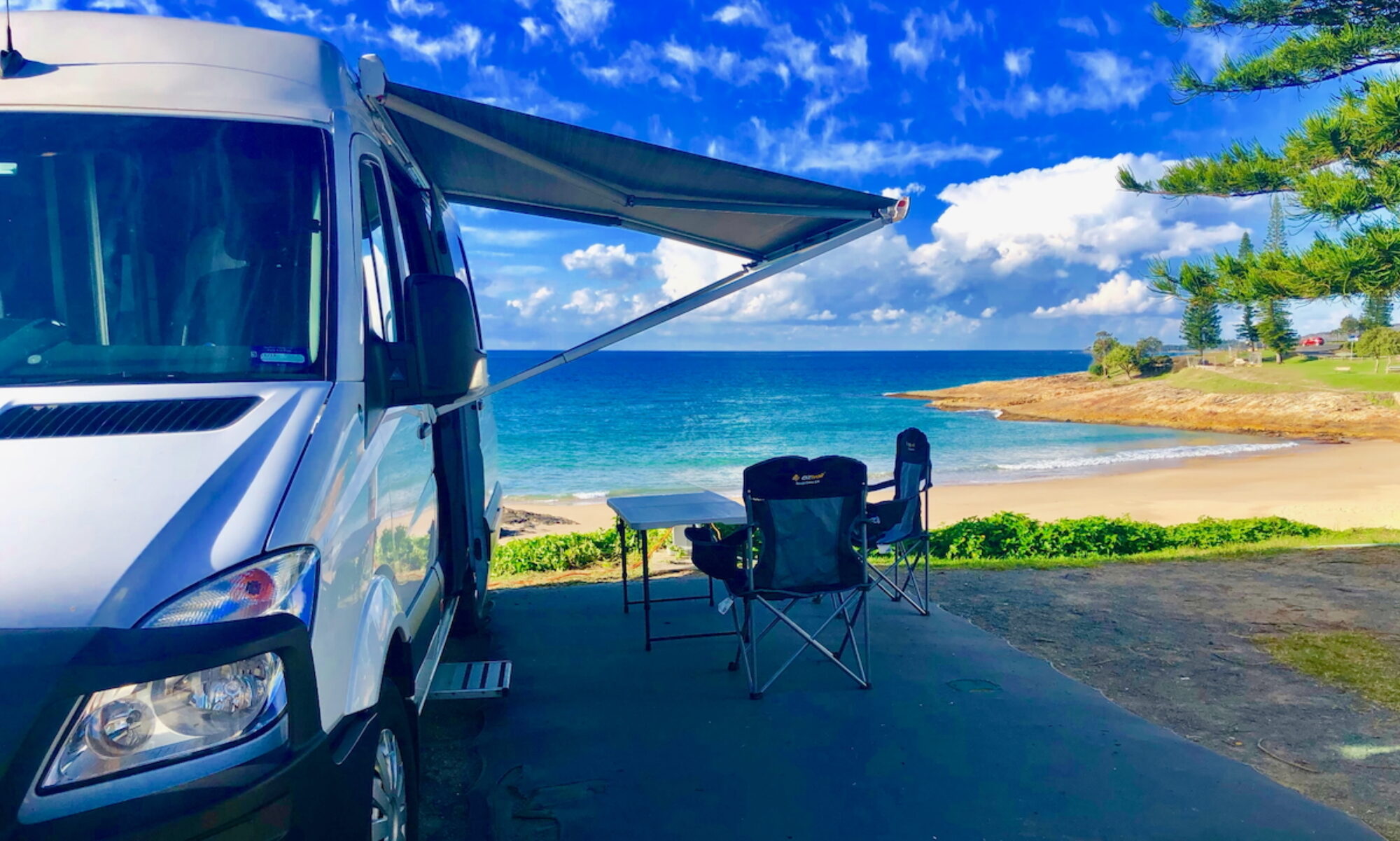Sustainability: Batteries & Solar | Water | Heating
Heating: Air Heating | Diesel or LPG Air Heating? | Hot Water & Cooking
Taking the Heat
If your travels are mostly on the Australian coast, or in other relatively mild climate environments, heating the living area of your van isn’t usually too much of a concern. Warm clothes and a quality doona will generally suffice for personal warmth on cooler evenings.
Once you get away from the coast in winter, and overnight temperatures drop to single figures, robust and reliable heating becomes a more serious consideration.
In an effort to keep advertised Motorhome prices down, ducted air heating is usually an optional extra in new vans. Consequently there is a healthy after-market industry supplying and fitting ducted heaters as add-ons to non-heated vans.
Heaters consume energy, sourced from fuel. But which fuel is best? If fitting a ducted heater to your van, what are your options?
On the Grid
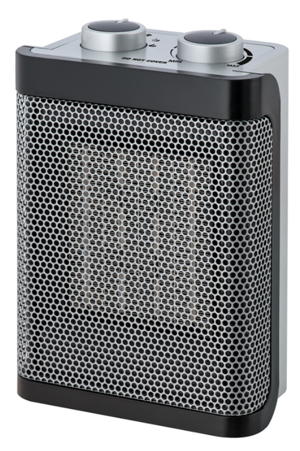
When staying in a formal campground with mains power available, a small 230V fan heater is the most cost-efficient heating option for the living area of your van.
A wide range of fan heaters are available to suit all sizes of Campervans and Motorhomes. They are portable and easily stored when travelling. When stopped for the night (with mains power available), the fan heater is plugged into a power outlet and sits on the floor of the van, heating the living area very quickly without consuming any of your on-board fuel supply.
A roof-mounted air conditioner with an in-built heating function is another heating option available in some vans, though where 230V power is available I would still rate our portable fan heater as being preferable to the heating facility in our roof-top air conditioner (read more here).
Off the Grid
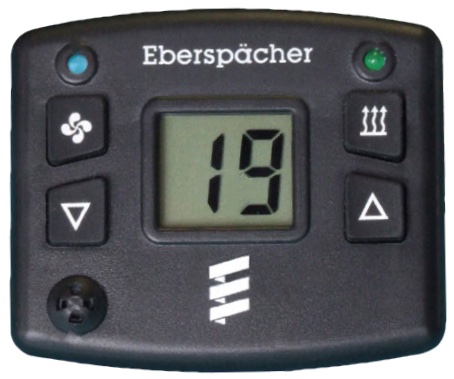 Once you are off-the-grid and free-camping, fuel sources for powering ducted air heating appliances are narrowed down to LPG (Liquefied Petroleum Gas) or Diesel. (Electricity supplied from a generator is also an option in some situations, which brings the fan heaters above back into consideration.)
Once you are off-the-grid and free-camping, fuel sources for powering ducted air heating appliances are narrowed down to LPG (Liquefied Petroleum Gas) or Diesel. (Electricity supplied from a generator is also an option in some situations, which brings the fan heaters above back into consideration.)
Both LPG- and Diesel-powered ducted air heaters do a great job of heating a Campervan or Motorhome, but there are pros and cons for each.
If you are thinking about retro-fitting ducted heating in your van, there are some parameters to consider when deciding which type of heater to install – not the least of which is what fuel sources you have available…..
Heating function
Both LPG- and Diesel-fuelled heaters use a heat exchange process to duct warm air to the living area of your Campervan or Motorhome.

Fuel (LPG or Diesel) is burned in a combustion chamber, heating the walls of the chamber. Air is blown over the hot outside walls of the chamber (fabricated with fins to increase the surface area and dissipate the heat), the resulting warm air being blown into the vehicle via flexible ducting.
The combustion chamber where the fuel is burned is completely separate from the compartment where the hot air is sourced, so no fumes from the burning fuel enter the vehicle. The combustion chamber’s air intake is drawn from outside the vehicle, and of course the exhaust is released outside the vehicle.
Fuel source options….
Diesel
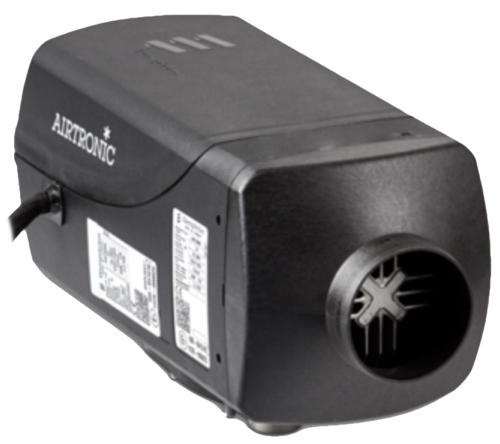 If your vehicle is a van-conversion or coach-body Campervan or Motorhome with a Diesel engine, then a Diesel heater is likely the default option.
If your vehicle is a van-conversion or coach-body Campervan or Motorhome with a Diesel engine, then a Diesel heater is likely the default option.
A fuel pickup can be connected into the vehicle’s main fuel tank to draw fuel for the heater. Some vans already have pickup connection points installed and ready to go. Others are DIY. The pickup pipe should be set at least 25mm above the bottom of the tank to ensure it doesn’t suck up any debris, and it can never use all the fuel! (Read more at DieselHeat.)
NOTE: You can’t tap into the Diesel fuel lines of modern Diesel vehicles. The common-rail system is pressurised and interfering with the system can cause major engine dramas.
-
- Diesel heaters use only a small amount of fuel – maybe a little more than a litre of Diesel if left running all night;
- The heater does not deplete your on-board LPG supply used for cooking and hot water;
- The heater’s fuel supply is topped up every time you fill your vehicle’s fuel tank;
- Connecting a Diesel heater to draw fuel from the vehicle’s fuel tank requires some specialist expertise, knowledge and experience. Some modern vans have pickup outlets factory installed, others involve lowering the fuel tank from under the vehicle and inserting a pickup tube to access fuel for the heater. (You can opt for a separate 10-litre diesel container if you prefer, though I wouldn’t recommend this in a Motorhome environment where the Diesel container would be installed inside the van.)
- The heater uses a small amount of 12V electricity to heat the glow plug when starting up, and to power the fuel pump, fan and control unit (10 amps at startup, 1 amp per hour).
LPG
 If your van is petrol-fuelled, or you have a slide-on camper (which isn’t able to have a permanent connection to the host vehicle’s Diesel fuel tank) and you already have an LPG installation for other appliances, an LPG ducted air heater is the go-to option. The heater can be connected into the existing LPG plumbing. (You could install a diesel heater in this situation, but this would require an additional fuel container.)
If your van is petrol-fuelled, or you have a slide-on camper (which isn’t able to have a permanent connection to the host vehicle’s Diesel fuel tank) and you already have an LPG installation for other appliances, an LPG ducted air heater is the go-to option. The heater can be connected into the existing LPG plumbing. (You could install a diesel heater in this situation, but this would require an additional fuel container.)
-
- There is no need to carry an additional fuel source – the heater uses the same LPG supply as your cooking and hot water appliances;
- LPG is widely available at LPG exchange outlets (eg Swap ‘n’ Go) at service stations, hardware stores and outdoors stores.
- Connecting your heater to existing LPG lines is usually a relatively straightforward job for a qualified gas fitter, depending on the location of the heater. Installation certification is mandatory;
- An LPG heater requires an exhaust flue fitted in the wall of the van. (There are strict guidelines on flue location, so exhaust fumes are not drawn into the van);
- The heater uses a small amount of 12V electricity to ignite the gas and to power the fan and control unit.
Heating function
![]() We had a ducted Diesel heater retro-fitted in our (diesel-powered) van a couple of years ago, and it is excellent. Friends have a ducted LPG heater installed in their slide-on camper, and they are equally happy with its performance. Neither heater has experienced any maintenance or reliability issues. Just press the ON button, set the temperature, and away they go. The living area is warm within minutes.
We had a ducted Diesel heater retro-fitted in our (diesel-powered) van a couple of years ago, and it is excellent. Friends have a ducted LPG heater installed in their slide-on camper, and they are equally happy with its performance. Neither heater has experienced any maintenance or reliability issues. Just press the ON button, set the temperature, and away they go. The living area is warm within minutes.
After browsing manufacturers’ sites and discussing experiences with other Campervan and Motorhome owners, there appear to be just a few measures that differentiate between LPG and Diesel-fuelled heaters….
-
- Modern Diesel heaters are microprocessor-controlled, providing ‘stepless’ incremental adjustments to the heat output when left running overnight. Once the living area is up to temperature the heater and fan taper off, ‘trickling’ on only when required to maintain the set temperature – you barely know the heater is running.
- LPG heaters have traditionally functioned in a more binary fashion, using a thermostat to switch the heater and fan either fully on or off as the internal cabin temperature varies. Recent models (eg Truma VarioHeat) have a very quiet night mode.
- Diesel heater exhausts are audible from outside the van, particularly when starting up. Once the cabin is up to temperature, and the heater has tapered off, external noise output from the heater is negligible.
- LPG heater units are quiet, the only noise output being from the internal fan.
- An LPG heater requires an external flue in the wall adjacent to the heater, as opposed to a Diesel heater’s exhaust pipe which is more easily fitted under the floor. There are regulations regarding the location of an LPG heater flue in relation to windows, doors and other LPG appliances, so that toxic exhaust gases aren’t able to be drawn into the living area.
- LPG burns less efficiently at high altitudes (over 600m). This can be an annoying issue with hot water heaters, and is likely to be an issue with air heaters too – though maybe less noticeable, particularly here in Australia, where our high altitudes aren’t that high! (Diesel heaters operate efficiently at altitudes up to 1500m.)

-
- In a compact Campervan or Motorhome one ducted outlet will warm the entire living space within a few minutes. Larger vans, with higher capacity heaters installed, can have multiple outlets – living area, dining area, sleeping area, even an outlet in the bathroom! Keep in mind though that many of these installations are designed to cater for the bitter cold winter climate of North America, Canada or Europe, rather than the comparatively mild Australian climate. (Cold? – that’s not cold!)

-
- A Diesel heater can be running while driving the van, so the living area is cozy and warm when you stop. This is particularly useful in very cold weather, or in a larger van with passengers travelling in the rear seats. Also handy to have the initial (noisier) warm-up period completed before pulling up in a quiet campground!
- Some websites (see links below) report that LPG heaters deliver a ‘damp heat’, causing humidity and condensation. This may be the case with regular domestic LPG heaters, but I don’t believe this to be true for ducted RV heaters that deliver their warmth from a heat exchanger. I expect that any moisture resulting from the Propane combustion process would be expelled through the flue with other exhaust.
Safety
![]() Though widely used and generally safe in modern installations, LPG has inherent risks with potential leaks, flammability and toxic exhaust gases.
Though widely used and generally safe in modern installations, LPG has inherent risks with potential leaks, flammability and toxic exhaust gases.
You don’t want to be exposed to exhaust gases from either Diesel or LPG heaters, so the heater exhaust / flue should be located away from living areas. LPG exhaust (carbon monoxide) is odourless and deadly. There are regulations defining the safe location of an LPG heater flue in relation to windows, doors and other air intakes for a Motorhome. These regulations often determine the installation location of an LPG heater in the van.
Important: Under no circumstances operate an LPG heater which uses an open flame to provide warmth in a Campervan or Motorhome. This includes using an LPG stove as a heater! (An LPG stove should only be used for cooking inside a van with adequate ventilation.) When LPG combusts it produces carbon monoxide which is odourless and deadly.
Other Considerations
-
 Uninterrupted internal air circulation in the van is required for air to be drawn into the heater air intake and warm air to be moved around the van. Be sure not to store equipment in a way that blocks or covers ventilation grills that feed air to the heater, which is usually installed in a cupboard or under the bed;
Uninterrupted internal air circulation in the van is required for air to be drawn into the heater air intake and warm air to be moved around the van. Be sure not to store equipment in a way that blocks or covers ventilation grills that feed air to the heater, which is usually installed in a cupboard or under the bed;- Diesel is more readily available than LPG in remote areas. This could be an important consideration if free-camping for extended periods of time in these areas;
- Well-known brand-name Diesel heaters (eg Eberspacher and Webasto) cost a few hundred dollars more than similar quality LPG heaters ($2100 v $1800 approx);
- Combined hot water and air heaters (eg Truma Combi) are available for saving space is smaller vans, though the water tank capacity is only 10 litres. Cost is around $2500 for LPG / 240V, or $3000 for Diesel;
- Some heater comparison sites suggest that LPG heaters may not function correctly when the temperature drops below 2°C, due to the Butane content of LPG. However, according to Origin Energy, Australian LPG (for non-car use) is 100% Propane, rather than a mixture of Propane and Butane as used in other countries. This should provide for satisfactory combustion of LPG at low temperatures;
- Diesel heaters may require periodic maintenance, such as cleaning or replacing the glow plug, removing carbon deposits from the combustion chamber and checking the fuel filter. (Running the heater at full heat for an hour or so assists in cleaning carbon deposits).
Cheap ‘Chinese’ Diesel Heaters
 Cheap ‘copy’ Diesel heaters are available on eBay for under $200. I have no first-hand experience with these units – though I expect they are cheap for a reason.
Cheap ‘copy’ Diesel heaters are available on eBay for under $200. I have no first-hand experience with these units – though I expect they are cheap for a reason.
DIY Diesel heater kits are supplied with a fuel container, which has to be fitted in the vehicle. This is more practical in a caravan with external storage, rather than a Motorhome. (Would you want to be filling a Diesel tank inside your van?)
Browsing through the online support sites and YouTube videos related to these heaters, it seems that there are plenty of happy DIY customers – though these folk appear to accept what I consider to be the shortcomings of these units as ‘normal’.
For example, one enthusiastic Australian YouTuber wasn’t concerned that the unit he bought didn’t include an exhaust tube, or an exhaust muffler. And that the fuel filter leaked. He was happy to rectify these issues as part of the DIY installation process.
So, here is my take on cheap Diesel ‘copy’ heaters….
-
- The heaters do seem to work, once various installation issues are resolved.
- These heater kits are not designed to be connected to your vehicle’s fuel tank, but rather to draw fuel from their own fuel bottle – making them more suited to caravan installations rather than Campervans or Motorhomes.
- The large number of contributors to online support sites for these devices is an indication of the number of installation and maintenance issues faced by owners.
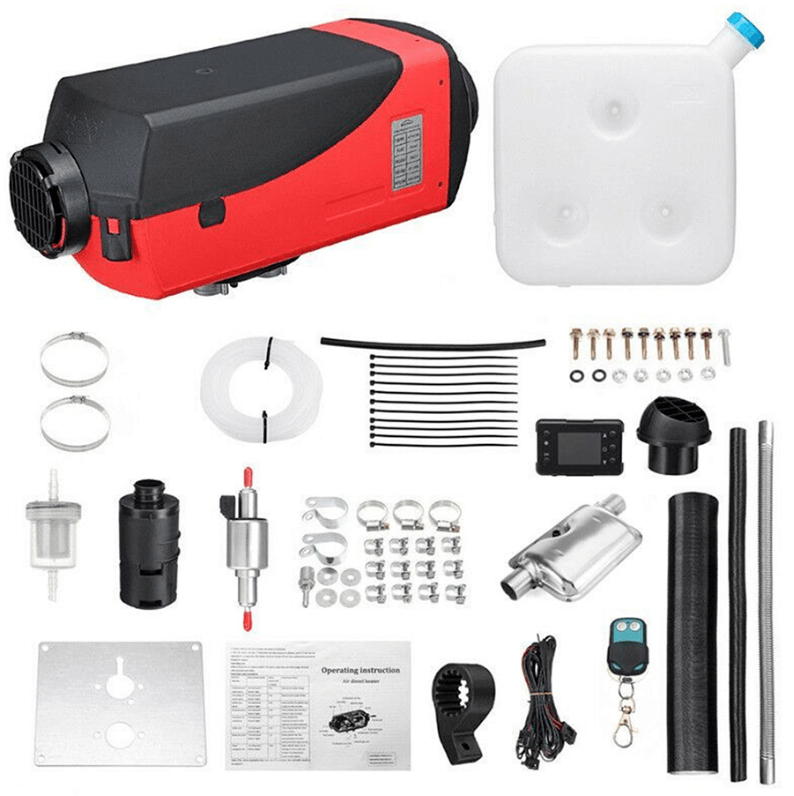 Reliability, parts availability, ongoing safety and general quality appear to be critical issues. Online forums suggest replacement parts can be difficult, if not impossible to obtain.
Reliability, parts availability, ongoing safety and general quality appear to be critical issues. Online forums suggest replacement parts can be difficult, if not impossible to obtain.- Some owners report that the fuel pumps and exhausts on these heaters are noisy, but describe this noise as ‘acceptable’.
- There are reports (from repair workshops) of inferior quality materials being used in the manufacture of combustion chambers, resulting in the chamber walls and seals deteriorating over time, potentially allowing noxious gases to leak and mix with the warm air ducted to the living area. (Worryingly, this deterioration is only discovered when the heater is being examined in relation to other issues. The owners aren’t aware of the possible fume leakage.)
- With the above long-term maintenance issues in mind, some owners seem content to take the risk and replace the heater every couple of years if required, still considering themselves to be ‘in front’ on the purchase price.
- I would suggest that if your van is worth somewhere between $40,000 and $200,000, it is a false economy to skimp on a cheap diesel heater, in return for ongoing maintenance issues and potential safety risks.
The Bottom Line
 In a nutshell, the type of heater you choose really comes down to the fuel source you have available…
In a nutshell, the type of heater you choose really comes down to the fuel source you have available…
-
- If your Campervan or Motorhome is Diesel-powered, go with a Diesel heater.
- If your vehicle is petrol-fuelled (or you have a slide-on) and you already have an LPG installation, go with an LPG heater.
- Both Diesel and LPG heaters will keep your living area warm in cold weather.
- Installation of a ducted air heater – in particular, connecting the heater to an existing fuel source – is not a trivial procedure.
- Have the heater – LPG or diesel – professionally installed.
- Cheap ‘copy’ diesel heaters are designed to be DIY, using their own fuel tank. This is more appropriate in a caravan installation where an external tank is more easily fitted (and filled!).
- A cheap diesel heater is likely to cause you grief in the future.
See also: Alternative fuels for RV appliances >>>
More information:
Chinese Diesel Heaters
|
Sustainability: Batteries & Solar | Water | Heating
Heating: Air Heating | Diesel or LPG Air Heating? | Hot Water & Cooking
